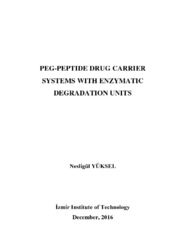Please use this identifier to cite or link to this item:
https://hdl.handle.net/11147/5696| Title: | Peg-Peptide Drug Carrier Systems With Enzymatic Degradation Units | Other Titles: | Enzimatik Bozunur Üniteli Peg-peptid İlaç Taşıyıcı Sistemleri | Authors: | Yüksel, Nesligül | Advisors: | Top, Ayben | Keywords: | Drug delivery systems Cancer cells Methoxy polyethylene glycol Peptide conjugation Lysosomal enzyme |
Publisher: | Izmir Institute of Technology Izmir Institute of Technology |
Source: | Yüksel, N. (2016). PEG-peptide drug carrier systems with enzymatic degradation units. Unpublished master's thesis, Izmir Institute of Technology, Izmir, Turkey | Abstract: | In this study, it was aimed to develop drug delivery systems with high drug release rate, capable of overcoming multidrug resistance of cancer cells. The first generation drug delivery system (DDS) denoted as mPEG-AT3-DOX was prepared by methoxy polyethylene glycol (mPEG) and peptide conjugation, and the model anticancer drug, DOX, was attached to the mPEG-peptide carrier system using stable amide linkage. mPEG was used to increase blood circulation time of the DDS. Designed peptide (AT3 = CG3H6R2ALALG3E) controls release of the drug via RRALAL sequence, which is a substrate for a lysosomal enzyme, cathepsin B, overexpressed in most of the tumor cells. pH responsive histidines and reactive amino acids (glutamic acid and cysteine) for drug and mPEG conjugations were also added to the peptide sequence. The peptide synthesized by using Fmoc chemistry was conjugated to mPEG-maleimide via Michael addition reaction. DOX was attached to the carboxylic acid group present in the carrier system (mPEG-AT3) via amide linkage. Mass spectroscopy and HPLC were used to assess the purity of the AT3 and mPEG-AT3. At pH 7.4, mPEG-AT3-DOX exhibited bimodal size (hydrodynamic diameter) distribution at about 15 and 30 nm independent of pH. % DOX release from mPEG-AT3-DOX was observed to be below 10 % at neutral pH and pH 5.0 in the absence of cathepsin B, and increased to 17 ± 2 % in the presence of cathepsin B. Complete degradation of AT3 peptide within three hours in the presence of cathepsin B suggests lower than expected DOX release is due to aggregation tendency of the DDS. Cytotoxicity of the conjugates was evaluated using the lung cancer (A549) and prostate cancer (PC3) cell lines. At the end of 24 hours the absolute IC50 values of free DOX and mPEG-AT3-DOX were obtained as 1.37 ± 0.05 and 1.33 ± 0.11 for the A549 cell line, 1.51 + 0.07 and 1.63 + 0.80 μg equivalent DOX / ml for the PC3 cell line, respectively. Considering, these results, the second generation DDS will be designed to have more pronounced pH sensitive property by increasing the number of histidines in the peptide domain. Bu çalışmada, kanser hücrelerinin çoklu ilaç direncinin çözümüne yönelik hızlı ilaç salım kabiliyetine sahip ilaç taşıyıcı sistemlerinin geliştirilmesi amaçlanmıştır. Birinci nesil ilaç taşıyıcı sistemi metoksi polietilen glikol ve peptid konjugasyonuyla hazırlanmış ve model kanser ilacı olan DOX, mPEG-peptid taşıyıcı sistemine kararlı amid bağı ile bağlanmıştır. İlaç taşıyıcı sisteminin kanda dolaşım süresini artırmak için mPEG kullanılmıştır. Tasarlanan peptid (AT3 = CG3H6R2ALALG3E) dizindeki RRALAL sayesinde bir çok kanserli hücrede aşırı üretilen lizozomal bir enzim olan katepsin B için substrat vazifesi görerek ilacın salınımı kontrol etmektedir. pH cevaplayabilen histidinler ile birlikte ilaç ve mPEG’in konjugasyonları için reaktif amino asitler de (glutamik asit ve sistein) peptid dizinine eklenmiştir. Fmoc kimyası uygulanarak sentezlenen peptidin mPEG-maleimid ile konjugasyonu Michael ekleme reaksiyonuyla gerçekleştirilmiştir. DOX ise taşıyıcı sistemde (mPEG-AT3) bulunan karboksilik asit gruplarına amid bağıyla bağlanmıştır. AT3 ve mPEG-AT3’ün saflığı kütle spektroskopisi ve HPLC kullanılarak belirlenmiştir. mPEG-AT3-DOX pH’tan bağımsız olarak yaklaşık 15 ve 30 nm’de ikili boyut (hidrodinamik çap) dağılımı göstermiştir. mPEG-AT3-DOX’un % DOX salımı nötral pH’da ve pH 5.0’te enzim kullanılmadığı zaman % 10’un altında; katepsin B varlığında ise % 17 2'ye çıkmıştır. AT3 peptidinin katepsin B varlığında 3 saat içinde parçalanması, beklenenden az gerçekleşen DOX salımının ilaç taşıyıcı sisteminin kümelenme eğilimi dolayısıyla olduğunu önermektedir. Konjugatların sitotoksisitesi akciğer kanseri (A549) ve prostat kanseri (PC3) hücre hatları kullanılarak belirlenmiştir. 24 saat sonunda, serbest DOX ve mPEG-AT3-DOX’un mutlak IC50 değerleri A549 hücre hattı için sırasıyla 1.37 0.05 ve 1.33 0.11 ve PC3 hücre hattı için sırasıyla 1.51 0.07 ve 1.63 0.80 g eşdeğer DOX/ml olarak elde edilmiştir. Bu sonuçları göze alarak ikinci nesil ilaç taşıyıcı sistemler peptid dizinine daha fazla histidin eklenerek pH’ya karşı daha duyarlı özellikte tasarlanacaktır. |
Description: | Thesis (Master)--Izmir Institute of Technology, Chemical Engineering, Izmir, 2016 Includes bibliographical references (leaves: 55-59) Text in English; Abstract: Turkish and English x, 61 leaves |
URI: | http://hdl.handle.net/11147/5696 |
| Appears in Collections: | Master Degree / Yüksek Lisans Tezleri |
Files in This Item:
| File | Description | Size | Format | |
|---|---|---|---|---|
| T001565.pdf | MasterThesis | 2.34 MB | Adobe PDF |  View/Open |
CORE Recommender
Page view(s)
230
checked on Apr 21, 2025
Download(s)
120
checked on Apr 21, 2025
Google ScholarTM
Check
Items in GCRIS Repository are protected by copyright, with all rights reserved, unless otherwise indicated.